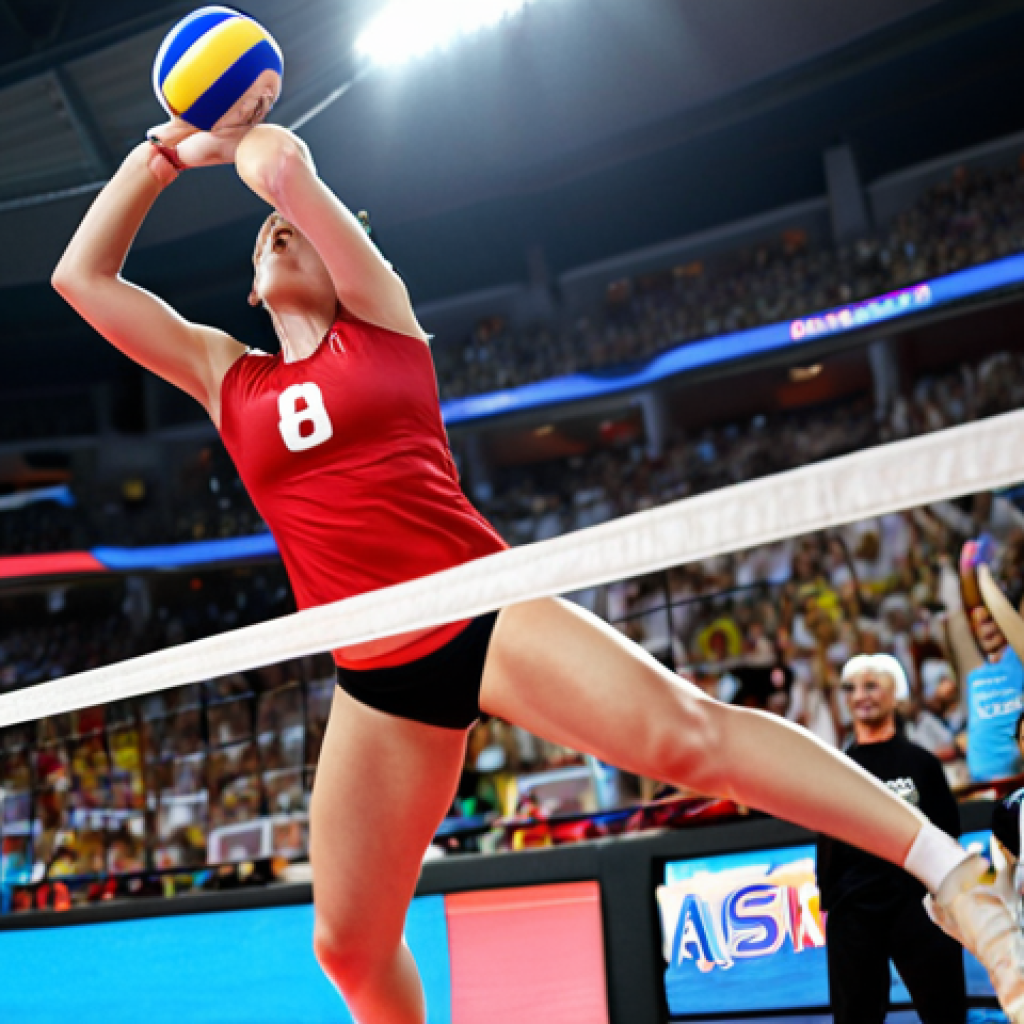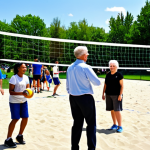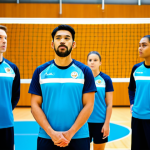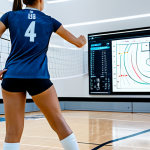Volleyball is a sport of explosive movements, quick reactions, and sustained effort. While strength and power are crucial, don’t underestimate the importance of a solid aerobic base.
Trust me, I’ve seen so many players gas out in the third set after dominating early on! Think of it like this: you can’t spike that winning point if you’re too winded to jump.
Aerobic exercise isn’t just about running laps; it’s about building the endurance to maintain peak performance throughout the entire match. Plus, the latest fitness trends emphasize HIIT workouts, which are fantastic for volleyball because they mimic the short bursts of energy needed during play.
So, are you ready to boost your volleyball game? Let’s dive into the details in the article below.
Alright, let’s get this volleyball endurance article spiked!
Building Your Aerobic Engine for Volleyball Domination

Volleyball isn’t just about explosive power; it’s about maintaining that power from the first serve to the final point. You’ve got to have that sustained energy.
Think about it, you’re constantly jumping, diving, and sprinting. That requires a serious aerobic base! I remember one tournament where our team completely fell apart in the later sets because we hadn’t put in the mileage during preseason.
We were all strong, but we just didn’t have the gas to keep up. Don’t make the same mistake!
Long Runs: The Foundation of Endurance
Don’t underestimate the power of good old-fashioned long runs. I know, I know, it’s not the most exciting thing in the world, but trust me, it works. Aim for 30-45 minute runs at a conversational pace a few times a week.
It builds your base fitness, improves cardiovascular health, and helps you recover faster between intense drills. Think of it as building the engine that powers your volleyball machine.
Interval Training: Simulating Game Intensity
Once you’ve got a good base, it’s time to add some spice with interval training. This involves alternating between high-intensity bursts and periods of rest or low-intensity activity.
For example, sprint for 30 seconds, then jog for 60 seconds. Repeat this for 20-30 minutes. This type of training mimics the stop-and-go nature of volleyball and helps you improve your anaerobic threshold.
Fueling Your Body for Peak Performance
Let’s face it: you can train all you want, but if you’re eating garbage, you’re not going to perform at your best. I remember when I thought I could eat whatever I wanted because I was “burning so many calories.” I was wrong.
I was sluggish, tired, and my performance suffered. It’s all about finding that sweet spot between fueling your body and eating the right things.
The Importance of Carbohydrates
Carbs are your primary fuel source for volleyball. Opt for complex carbohydrates like whole grains, fruits, and vegetables. These provide sustained energy throughout the match.
I always make sure to have a bowl of oatmeal or whole-wheat toast a couple of hours before a game or practice. It gives me the energy I need without the sugar crash.
Protein for Muscle Repair and Growth
Protein is essential for repairing and building muscle tissue. Aim for a protein source with every meal. Think lean meats, poultry, fish, beans, lentils, and tofu.
Post-workout, I usually have a protein shake or a Greek yogurt with berries to help my muscles recover.
Strategic Aerobic Drills to Enhance Your Volleyball Skills
Aerobic training isn’t just about running. You can incorporate drills that specifically target the movements and skills used in volleyball while simultaneously building your endurance.
It’s like hitting two birds with one stone! When I was coaching, this was the best way to work cardio into our team practices!
Shuttle Runs with a Twist
Forget basic shuttle runs. Incorporate volleyball skills like setting, passing, and spiking into your shuttle runs. This not only improves your aerobic capacity but also enhances your volleyball skills and coordination under pressure.
For example, sprint to a cone, pass a ball to a target, sprint to another cone, set a ball, and so on.
Agility Ladder Workouts
Agility ladder drills are fantastic for improving footwork, speed, and coordination. They also provide a great cardio workout. Try different variations of agility ladder drills, such as lateral shuffles, in-and-outs, and Icky Shuffles.
Recovery: The Often-Overlooked Key to Endurance
You can’t just train hard; you also need to recover hard. I’ve learned this the hard way. Pushing myself too hard without proper recovery led to injuries and burnout.
Now, I prioritize recovery just as much as training. Don’t skip your recovery days!
Active Recovery: Light Movement is Key
Active recovery involves light activity, such as walking, swimming, or yoga, to promote blood flow and reduce muscle soreness. This helps flush out metabolic waste and speeds up the recovery process.
After a tough practice, I like to go for a leisurely walk or do some light stretching.
Proper Sleep: Your Body’s Repair Shop
Sleep is crucial for recovery. Aim for 7-9 hours of quality sleep each night. This is when your body repairs muscle tissue and restores energy levels.
Create a relaxing bedtime routine, such as reading a book or taking a warm bath, to promote better sleep.
Monitoring Your Progress: Tracking Your Aerobic Fitness
It’s important to track your progress so you can see how far you’ve come and make adjustments to your training plan. This way, you are getting better with time.
I used to just wing it, but I found that tracking my progress kept me motivated and helped me identify areas where I needed to improve.
Heart Rate Monitoring: A Window into Your Fitness
Use a heart rate monitor to track your heart rate during workouts. This can help you ensure you’re training in the right heart rate zones for aerobic development.
There are tons of affordable options out there; it will feel like a cheat sheet.
The Talk Test: A Simple Way to Gauge Intensity
The talk test is a simple way to gauge your workout intensity. If you can comfortably hold a conversation while exercising, you’re likely in the aerobic zone.
If you’re gasping for air and can barely speak, you’re probably pushing too hard.
Avoiding Overtraining: Listen to Your Body
Overtraining can sabotage your progress and lead to injuries. It’s important to listen to your body and take rest days when needed. I remember pushing myself so hard that I ended up with a stress fracture.
It sidelined me for months! Don’t let that happen to you.
Recognizing the Signs of Overtraining
Symptoms of overtraining include fatigue, decreased performance, increased muscle soreness, irritability, and sleep disturbances. If you experience any of these symptoms, take a break from training and prioritize recovery.
The Importance of Rest Days
Rest days are just as important as training days. They give your body time to recover and rebuild. Schedule at least one or two rest days per week.
Don’t feel guilty about taking a day off. Your body will thank you for it.
Sample Weekly Training Schedule
Here’s a sample weekly training schedule that incorporates aerobic exercise for volleyball players. Remember to adjust the schedule based on your individual needs and fitness level.
| Day | Activity | Duration | Intensity |
|---|---|---|---|
| Monday | Long Run | 30-45 minutes | Conversational Pace |
| Tuesday | Volleyball Practice | 2 hours | High |
| Wednesday | Active Recovery (Yoga or Swimming) | 30-45 minutes | Low |
| Thursday | Interval Training | 20-30 minutes | High/Low |
| Friday | Volleyball Practice | 2 hours | High |
| Saturday | Rest | – | – |
| Sunday | Long Walk/Light Activity | 60 minutes | Low |
Incorporating Mindfulness to Improve Performance
It’s important to include mindfulness in your practices. Mindfulness can help you cope with game day anxiety!
Practicing Meditation
Meditation is a great way to relieve stress. It is also a great way to boost focus.
Practicing Visualization
Visualization can help you prepare for a game. You can mentally plan how you want to do things. Alright, let’s get this volleyball endurance article spiked!
Building Your Aerobic Engine for Volleyball Domination
Volleyball isn’t just about explosive power; it’s about maintaining that power from the first serve to the final point. You’ve got to have that sustained energy. Think about it, you’re constantly jumping, diving, and sprinting. That requires a serious aerobic base! I remember one tournament where our team completely fell apart in the later sets because we hadn’t put in the mileage during preseason. We were all strong, but we just didn’t have the gas to keep up. Don’t make the same mistake!
Long Runs: The Foundation of Endurance
Don’t underestimate the power of good old-fashioned long runs. I know, I know, it’s not the most exciting thing in the world, but trust me, it works. Aim for 30-45 minute runs at a conversational pace a few times a week. It builds your base fitness, improves cardiovascular health, and helps you recover faster between intense drills. Think of it as building the engine that powers your volleyball machine.
Interval Training: Simulating Game Intensity
Once you’ve got a good base, it’s time to add some spice with interval training. This involves alternating between high-intensity bursts and periods of rest or low-intensity activity. For example, sprint for 30 seconds, then jog for 60 seconds. Repeat this for 20-30 minutes. This type of training mimics the stop-and-go nature of volleyball and helps you improve your anaerobic threshold.
Fueling Your Body for Peak Performance
Let’s face it: you can train all you want, but if you’re eating garbage, you’re not going to perform at your best. I remember when I thought I could eat whatever I wanted because I was “burning so many calories.” I was wrong. I was sluggish, tired, and my performance suffered. It’s all about finding that sweet spot between fueling your body and eating the right things.
The Importance of Carbohydrates
Carbs are your primary fuel source for volleyball. Opt for complex carbohydrates like whole grains, fruits, and vegetables. These provide sustained energy throughout the match. I always make sure to have a bowl of oatmeal or whole-wheat toast a couple of hours before a game or practice. It gives me the energy I need without the sugar crash.
Protein for Muscle Repair and Growth
Protein is essential for repairing and building muscle tissue. Aim for a protein source with every meal. Think lean meats, poultry, fish, beans, lentils, and tofu. Post-workout, I usually have a protein shake or a Greek yogurt with berries to help my muscles recover.
Strategic Aerobic Drills to Enhance Your Volleyball Skills
Aerobic training isn’t just about running. You can incorporate drills that specifically target the movements and skills used in volleyball while simultaneously building your endurance. It’s like hitting two birds with one stone! When I was coaching, this was the best way to work cardio into our team practices!
Shuttle Runs with a Twist
Forget basic shuttle runs. Incorporate volleyball skills like setting, passing, and spiking into your shuttle runs. This not only improves your aerobic capacity but also enhances your volleyball skills and coordination under pressure. For example, sprint to a cone, pass a ball to a target, sprint to another cone, set a ball, and so on.
Agility Ladder Workouts
Agility ladder drills are fantastic for improving footwork, speed, and coordination. They also provide a great cardio workout. Try different variations of agility ladder drills, such as lateral shuffles, in-and-outs, and Icky Shuffles.
Recovery: The Often-Overlooked Key to Endurance
You can’t just train hard; you also need to recover hard. I’ve learned this the hard way. Pushing myself too hard without proper recovery led to injuries and burnout. Now, I prioritize recovery just as much as training. Don’t skip your recovery days!
Active Recovery: Light Movement is Key
Active recovery involves light activity, such as walking, swimming, or yoga, to promote blood flow and reduce muscle soreness. This helps flush out metabolic waste and speeds up the recovery process. After a tough practice, I like to go for a leisurely walk or do some light stretching.
Proper Sleep: Your Body’s Repair Shop
Sleep is crucial for recovery. Aim for 7-9 hours of quality sleep each night. This is when your body repairs muscle tissue and restores energy levels. Create a relaxing bedtime routine, such as reading a book or taking a warm bath, to promote better sleep.
Monitoring Your Progress: Tracking Your Aerobic Fitness
It’s important to track your progress so you can see how far you’ve come and make adjustments to your training plan. This way, you are getting better with time. I used to just wing it, but I found that tracking my progress kept me motivated and helped me identify areas where I needed to improve.
Heart Rate Monitoring: A Window into Your Fitness
Use a heart rate monitor to track your heart rate during workouts. This can help you ensure you’re training in the right heart rate zones for aerobic development. There are tons of affordable options out there; it will feel like a cheat sheet.
The Talk Test: A Simple Way to Gauge Intensity
The talk test is a simple way to gauge your workout intensity. If you can comfortably hold a conversation while exercising, you’re likely in the aerobic zone. If you’re gasping for air and can barely speak, you’re probably pushing too hard.
Avoiding Overtraining: Listen to Your Body
Overtraining can sabotage your progress and lead to injuries. It’s important to listen to your body and take rest days when needed. I remember pushing myself so hard that I ended up with a stress fracture. It sidelined me for months! Don’t let that happen to you.
Recognizing the Signs of Overtraining
Symptoms of overtraining include fatigue, decreased performance, increased muscle soreness, irritability, and sleep disturbances. If you experience any of these symptoms, take a break from training and prioritize recovery.
The Importance of Rest Days
Rest days are just as important as training days. They give your body time to recover and rebuild. Schedule at least one or two rest days per week. Don’t feel guilty about taking a day off. Your body will thank you for it.
Sample Weekly Training Schedule
Here’s a sample weekly training schedule that incorporates aerobic exercise for volleyball players. Remember to adjust the schedule based on your individual needs and fitness level.
| Day | Activity | Duration | Intensity |
|---|---|---|---|
| Monday | Long Run | 30-45 minutes | Conversational Pace |
| Tuesday | Volleyball Practice | 2 hours | High |
| Wednesday | Active Recovery (Yoga or Swimming) | 30-45 minutes | Low |
| Thursday | Interval Training | 20-30 minutes | High/Low |
| Friday | Volleyball Practice | 2 hours | High |
| Saturday | Rest | – | – |
| Sunday | Long Walk/Light Activity | 60 minutes | Low |
Incorporating Mindfulness to Improve Performance
It’s important to include mindfulness in your practices. Mindfulness can help you cope with game day anxiety!
Practicing Meditation
Meditation is a great way to relieve stress. It is also a great way to boost focus.
Practicing Visualization
Visualization can help you prepare for a game. You can mentally plan how you want to do things.
In Conclusion
Boosting your aerobic endurance is a game-changer for volleyball performance. Remember to build a solid aerobic base, fuel your body wisely, and prioritize recovery. By incorporating these strategies into your training, you’ll be able to dominate on the court from the first serve to the final point. Now, go out there and get after it!
Useful Information to Know
1. Consider joining a local running club for motivation and community support. Many cities have groups that meet regularly and offer training plans for all levels.
2. Experiment with different pre-game meals to find what works best for your body. Some athletes swear by a banana and peanut butter, while others prefer a light smoothie.
3. Invest in a good foam roller to help with muscle recovery. Use it after practices and games to release tension and improve flexibility.
4. Find a good sports psychologist who can help you navigate the mental aspects of the game. They can provide strategies for managing stress, building confidence, and staying focused under pressure.
5. Stay hydrated! Always carry a water bottle with you and sip on it throughout the day, especially during practices and games. Dehydration can significantly impact your performance.
Key Takeaways
Prioritize long runs and interval training to build your aerobic engine.
Fuel your body with complex carbs and protein for sustained energy and muscle repair.
Incorporate strategic aerobic drills into your volleyball practices.
Never underestimate the importance of recovery and proper sleep.
Listen to your body and avoid overtraining.
Frequently Asked Questions (FAQ) 📖
Q: I’m a setter, so I don’t do as much spiking and jumping. Do I really need aerobic exercise, or is it more for hitters?
A: Dude, absolutely! As a setter, you’re constantly moving, anticipating, and reacting. You’re the quarterback of the team!
Sure, you might not be jumping and spiking as much as the hitters, but you’re still hustling non-stop. Plus, good aerobic fitness helps with mental clarity and quick decision-making, which is super important for a setter.
Trust me, I’ve seen setters make bad choices late in a game because they were gassed. Don’t let that be you!
Q: HIIT workouts sound intense! I’m already pretty tired after practice. Won’t that just make me more exhausted?
A: I get it, believe me! After a brutal practice, the last thing you want is more exercise. But the beauty of HIIT is that it’s short and sweet.
We’re talking like 20-30 minutes, max. And you can adjust the intensity to your fitness level. Start slow, focus on proper form, and gradually increase the intensity as you get fitter.
Think of it as investing in your future energy levels! Instead of feeling drained in the third set, you’ll be the one with the energy to burn. Plus, a good workout can actually boost your energy levels in the long run.
Ever heard of that “runner’s high?” It’s a real thing!
Q: Okay, I’m convinced. But what kind of aerobic exercise is best for volleyball? Just running?
A: Running is fine, but it can get boring! Mix it up! Think about activities that mimic the movements of volleyball.
Agility drills, shuttle runs, jumping rope – these are all great options. Swimming is also fantastic because it’s low-impact and works your whole body.
And don’t forget about things like biking or even dancing! The key is to find something you enjoy so you’ll actually stick with it. I personally love doing beach runs in the off-season.
The soft sand is killer on your legs, but it builds serious endurance. Plus, the ocean view is pretty darn motivating!
📚 References
Wikipedia Encyclopedia
구글 검색 결과
구글 검색 결과
구글 검색 결과
구글 검색 결과
구글 검색 결과





